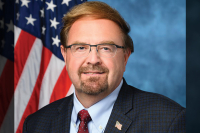Big decisions ahead in debate over land-use plan
A steering committee tasked with examining and recommending possible changes to Waynesville’s land-use plan is finally getting down to brass tacks.
Town aldermen commissioned the project nearly a year-and-a-half ago as a five-year review of how the town’s new land-use plan is working. A land-use planning consulting firm was brought on board for a fee of $54,000 to collect input and offer an assessment of problem areas in the comprehensive town ordinance. The consultant, Craig Lewis with the Lawrence Group out of Davidson, delivered his initial assessment to the steering committee last week.
The steering committee will begin holding twice-a-month meetings to plow through the issues identified by the consultant.
Lewis said one of the biggest gains the town will see at the end of the process is an ordinance that is easier to use. He called the current document “disorganized.”
“There are cross-references everywhere. There are requirements you need to know that are hidden in the definitions or hidden in special use requirements,” Lewis said. “If we do nothing else but reorganize and simplify it, I think we have earned our fee in this project.”
Waynesville’s land-use plan promotes pedestrian-friendly development and aesthetic standards for commercial development in an attempt to preserve small-town character. It was praised by smart growth groups throughout the state for its novel approach.
Related Items
The land-use plan lays out guidelines tailored to 29 different neighborhood and business districts throughout town.
“It’s a ton of districts, more than I have ever seen for a community of your size,” Lewis said. “The initial reaction is ‘That’s too many.’ After looking through it and talking with you, I would say right now, I can’t come up with a good reason to throw that baby out.”
Lewis said they could be made more uniform and the language made much simpler, however. For example, the maximum size for signs between similar districts might vary by as little as four square feet.
Town Manager Lee Galloway said the myriad districts were an attempt to let each part of town dictate what type of development would best fit that area. It was also intended to be user-friendly.
“You could pick up the plan for the Raccoon neighborhood district and know exactly the rules in your district,” Galloway said.
But the result has been a nightmare for the town planner and zoning enforcement officer who have to keep all those rules straight.
“We want to satisfy the irritated without irritating the satisfied,” Lewis said of the pending rewrite.
Parking lot placement
The looming hot-button issue the committee will face is whether parking should continue to be relegated to the side and rear of businesses. Indeed, dissatisfaction over that issue drove town leaders to sanction the five-year review of the land-use plan.
“This is a clear issue that is gong to warrant more discussion from you all,” Lewis told the steering committee.
Lewis said there are merits to the town’s protocol. By placing parking to the rear and side of businesses, the streetscape is defined by building facades, sidewalks and street trees rather than expansive asphalt parking lots. Lewis said those who oppose the policy hold up two businesses on Russ Avenue as examples: Home Trust Bank and CVS, which sit across the street from each other on the commercial thoroughfare. While CVS has parking to the rear and side rather than in front, the building is far less attractive than Home Trust Bank, which has parking in front.
“People say the reason they need front-yard parking is because CVS is not a good- looking building,” Lewis said. “It is very stark along the front. The windows are small. It is squatty proportionally. It has a high, harsh retaining wall.”
Meanwhile, Home Trust Bank is handsome, he said.
“It has varied rooflines. There are more window openings. It has columns. It is more residential looking. The landscaping looks a little bit softer,” Lewis said.
The comparison between the buildings has nothing to do with whether parking is permitted in front, however, according to Lewis.
“Those are two different issues,” Lewis said. “I wouldn’t say we want to throw everything out all over town because of those issues.”
Town Planner Paul Benson said the town’s land-use plan attempts to dictate architecturally pleasing buildings, but the intent was skirted by CVS.
“It’s where our current ordinance really failed us,” Benson said. “They could comply with the letter of our current ordinance without creating a good building.”
But Joe Taylor, a member of the steering committee, questioned how the town can police the aesthetic appearance of a building.
“When you look at the beauty or lack of beauty in a building, that is a matter of opinion,” Taylor said.
Another issue facing the committee is whether businesses should be required to connect their parking lots. Currently, the land-use plan requires new businesses to provide passage for cars between parking lots behind their buildings.
Taylor, who owns the Ford dealership on Russ Avenue, said he doesn’t like the idea of people cutting through his parking lot to get the restaurant next door.
“So you are saying you want all the cars to go back out on to the main road if they are going from one place to another?” Lewis countered. “Generally speaking connecting driveways is the number one way to improve traffic flow on the main road.”
Taylor said if the town wants to create an extra street for traffic to move between buildings it should buy the right of way and build the street itself rather expect businesses to undertake it.
Where from here?
Ultimately, any changes to the town’s land-use plan or building standards must be approved by the town board. The steering committee will merely do the legwork and make recommendations.
Members of the steering committee questioned whether they should accommodate public input during their part of the process, or wait until the recommendations are sent up the chain to the town board.
“Do you want to try to integrate some wider public participation on our end of the process or wait until the end?” Bradshaw asked.
“I think we should have some feedback in the middle somewhere,” said Steve Kaufman, a committee member and president of Reece, Noland and McElrath engineering firm.
The committee agreed that it would be good to solicit input along the way on some of the more volatile issues.
Only four of the eight members of the steering committee were present for the meeting last week. Two had said ahead of time they couldn’t come, while two were no-shows at the last minute. It was only the second meeting of the full committee that afforded face time with the consultant.
The committee agreed to meet every other Wednesday from 7:30 a.m. to 9 a.m., although the consultant, who is based in Davidson, won’t be attending. The first meeting will be held Sept. 2.
Waynesville’s land-use plan steering committee members:
• David Blevins, appointed by Alderman Gary Caldwell
• Patrick Bradshaw, appointed by Mayor Gavin Brown
• Steve Kaufman, appointed by Alderwoman Libba Feichter
• Joe Taylor, appointed by former Alderman Kenneth Moore
• Ken Wilson, appointed by Alderman Leroy Robeson
• Patrick McDowell, chairman of the planning board
• Daniel Hyatt, chairman of the community appearance commission
• Mike Erwin, chairman of the board of adjustment









